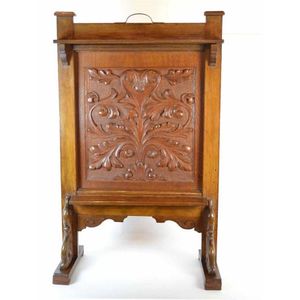Victorian Cabinet on Stand with Multiple Pigeonholes
You must be a subscriber, and be logged in to view price and dealer details.
Subscribe Now to view actual auction price for this item
When you subscribe, you have the option of setting the currency in which to display prices to $Au, $US, $NZ or Stg.
- Victorian Period - The Victorian period of furniture and decorative arts design covers the reign of Queen Victoria from 1837 to 1901. There was not one dominant style of furniture in the Victorian period. Designers used and modified many historical styles such as Gothic, Tudor, Elizabethan, English Rococo, Neoclassical and others, although use of some styles, such as English Rococo and Gothic tended to dominate the furniture manufacture of the period.
The Victorian period was preceded by the Regency and William IV periods, and followed by the Edwardian period, named for Edward VII (1841 ? 1910) who was King of the United Kingdom and the British Dominions and Emperor of India for the brief period from 1901 until his death in 1910. - Turning - Any part of a piece of furniture that has been turned and shaped with chisels on a lathe. Turned sections include legs, columns, feet, finials, pedestals, stretchers, spindles etc. There have been many varieties and fashions over the centuries: baluster, melon, barley-sugar, bobbin, cotton-reel, rope-twist, and so on. Split turning implies a turned section that has been cut in half lengthwise and applied to a cabinet front as a false decorative support.
- Turned Legs - are legs which have been turned on a lathe. In use from the 16th century, turned legs on tables, chairs and cabinets became more frequent until, by the 1830s, the Georgian square or tapered leg was rarely found except in country pieces.
- Fall Front - Furniture with a hinged flap, usually associated with desks and secretaires, that opens or 'falls' to provide a flat writing surface. The flap may be supported by chains or brass quadrants and rest on wooden supports or runners, known as lopers, that pull out from a recess in either side of the piece. The interior of a fall-front desk is usually fitted with small drawers and pigeonholes.
This item has been included into following indexes:
Visually similar items

A West Australian Arts & Crafts style jarrah and Sheoak fire screen, early 20th century school of William Howitt (1846-1928), probably by one of his students the central sheoak panel decorated with carved acanthus leaves and scroll motifs. Height 83 cm, wi

A French beech and gilt bronze mounted jardiniere, attributed to Gabriel Viardot (1830-1906), last quarter 19th century, in the 'Japonisme style', the oblong top inset with a lead lined receptacle, the pierced lattice frieze centred by gilt bronze mask hea

Antique French satinwood Louis XVI nightstand, with inset marble top and tambour top section

A French carved walnut dough bin on stand, first half 20th century, the removable serpentine top above the flaring sides of the bin, resting on a stand with shaped aprons and low stretchers between turned supports, the front relief-carved throughout with c
